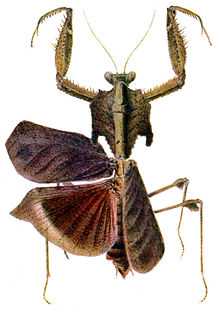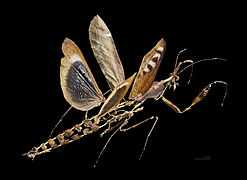Deroplatys desiccata
| Deroplatys desiccata | |
|---|---|
 | |
| Adult female Deroplatys desiccata | |
| Scientific classification | |
| Kingdom: | Animalia |
| Phylum: | Arthropoda |
| Class: | Insecta |
| Order: | Mantodea |
| Family: | Mantidae |
| Subfamily: | Deroplatyinae |
| Tribe: | Deroplatyini |
| Genus: | Deroplatys |
| Species: | D. desiccata |
| Binomial name | |
| Deroplatys desiccata Beier, 1935 | |
| Synonyms | |
| |
Deroplatys desiccata, known by the common names Giant Dead Leaf Mantis and (less-frequently) Malaysian Dead Leaf Mantis, is a species of praying mantis from Southeast Asia.[1]
Description
D. desiccata takes its common name from its resemblance to dead, leafy vegetation including having a flattened, greatly extended thorax and "intricate leaf patterns" on its wings.[2][3] This insect varies in color from mottled brown through "pale orangey brown" to a very dark brown that is almost black.[4]
This creature's camouflage is aided by its movements as well as its appearance. When disturbed, it rocks gently as if caught in the breeze. When threatened, it typically falls to the ground and lies motionless.[4][5][6][7] It can also react with a threatening display consisting of "black underwings splayed out, with large eyespots, frightening away unsuspecting predators."[8]
As its common name indicates, D. desiccata is larger than other species of Dead Leaf Mantis. Females grow to 75-80mm long. Displaying the sexual dimorphism typical of mantises, males grow only 65-70mm long and are substantially smaller and lighter than females.[4][5][9][10] Females’ prothorax shields end in a sharp pointed curve on each side while the males have a rounder shape. According to one source, males tend to be more "yellowish" than the darker females.[1]
-

Adult female at Bristol Zoo2007
-

Male prepared in the Beauchene technique.
Diet
Like most mantises, this species has little or no food preferences as long as the prey is the right size, but one source does observe that they "especially love flying insects like moths." [4]
Range
D. desiccata inhabits scrubland and forests in Borneo, Indonesia, Malaysia, and Sumatra.[5][10]
In Captivity
D. desiccata is one of many mantids that can be kept as pets. In captivity, the diet of nymphs often consists of flightless fruit flies, pinhead crickets, and other small insects. Adults are fed crickets, moths, flies, flour worms, and other large insects. In order to survive outside the tropics, D. desiccata requires high levels of heat and humidity similar to that of its native habitat in Southeast Asia, between 75° - 90 °F (24° - 32 °C), and more than 75% humidity. Males go through 8 molts while females go through 9.
See also
- Dead Leaf Mantis
- List of mantis genera and species
References
- ↑ 1.0 1.1 mantisphotos.com: Malaysian Dead Leaf Mantis
- ↑ mantiskingdom.com: Dead Leaf Mantis D. Desiccata
- ↑ Tree of Life Web Project. Deroplatys desiccata. Version 14 March 2006
- ↑ 4.0 4.1 4.2 4.3 Species of mantids: Dead Leaf Praying Mantid
- ↑ 5.0 5.1 5.2 Dead exotic-pets.co.uk: Leaf Praying Mantis
- ↑ shearyadi.com: Greatest animals camouflage
- ↑ animalpicturesarchive.com: Dead Leaf Mantis (Deroplatys desiccata) camouflage
- ↑ bugsincyberspace.com: Deroplatys desiccata
- ↑ http://www.mantisonline.de/index.php?lan=en&show=species_mantids_view&content=a:6:{s:7:%22subshow%22;s:15:%22species_mantids%22;s:10:%22level_left%22;s:3:%22def%22;s:5:%22genus%22;s:10:%22deroplatys%22;s:18:%22level_left_species%22;s:5:%22index%22;s:7:%22species%22;s:9:%22desiccata%22;s:23:%22level_left_species_mode%22;s:7:%22general%22;}
- ↑ 10.0 10.1 Phasmids in Cyberspace: Deroplatys dessicata